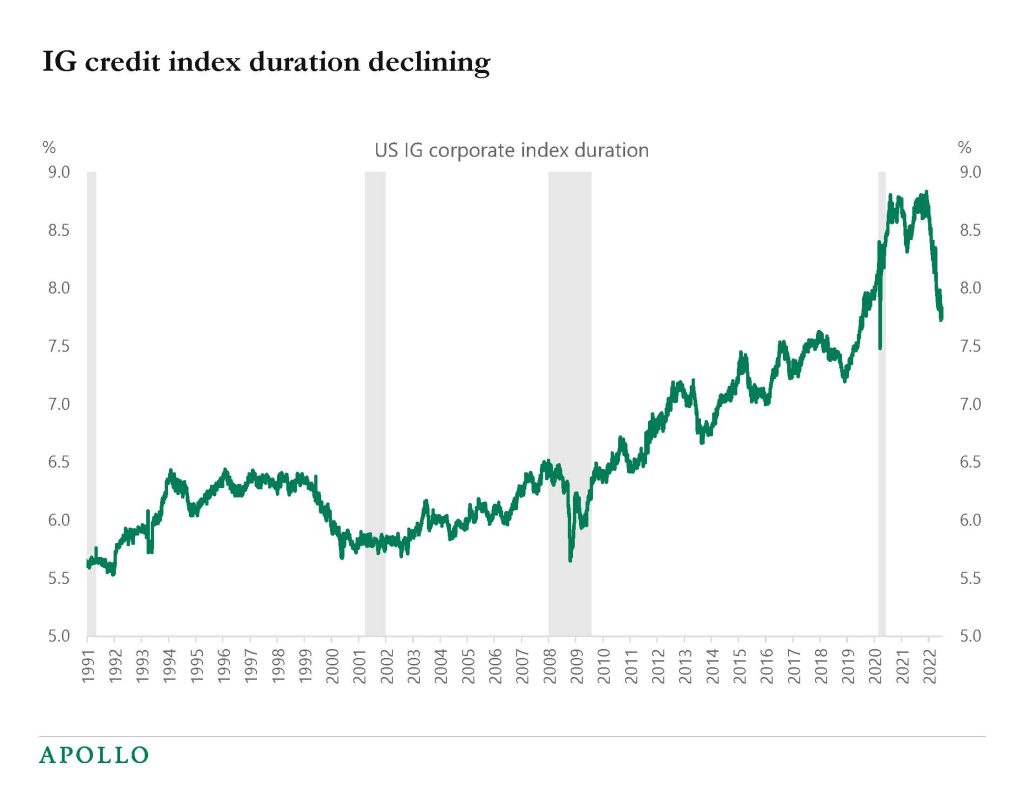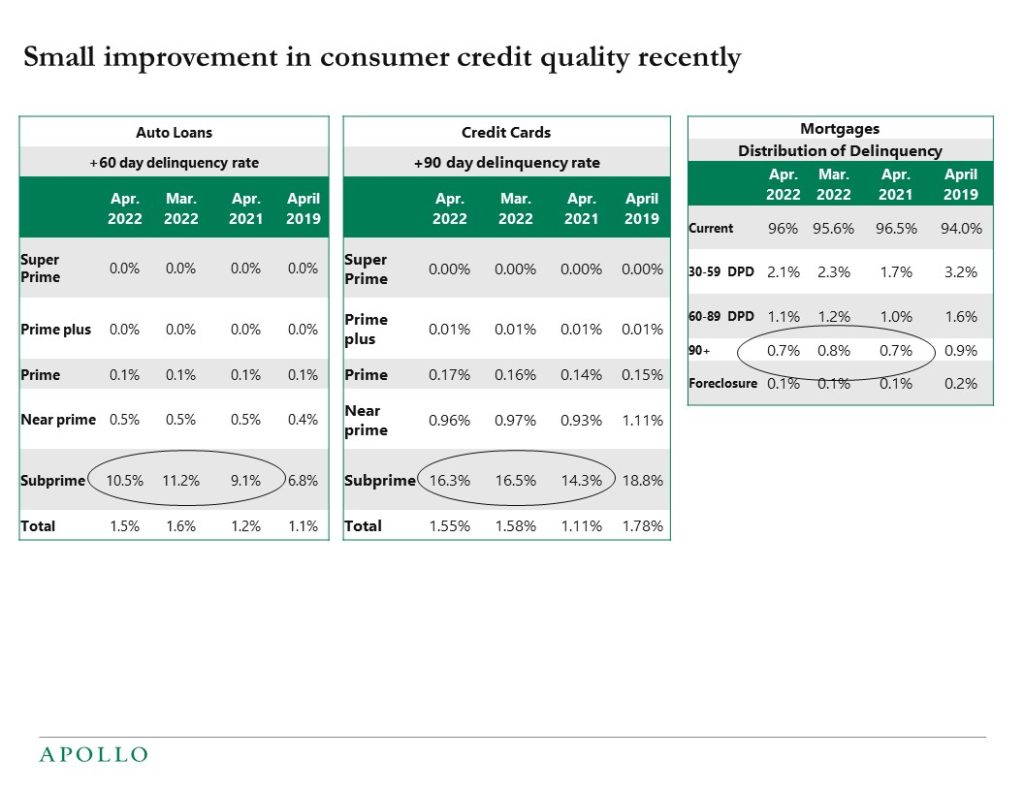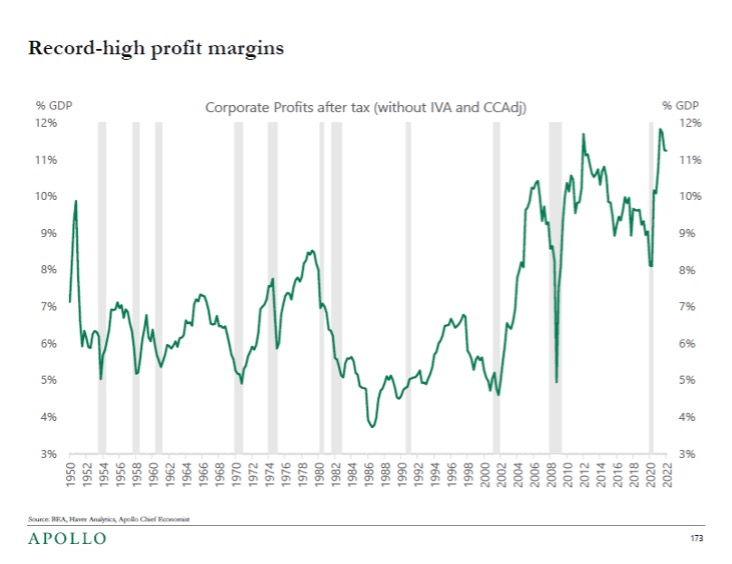Want it delivered daily to your inbox?
-
Since employment declined by 22 million jobs during the pandemic, about 21.5 million jobs have been created. But the distribution of the jobs created has been uneven, with some sectors today having employment above February 2020 levels and others having employment levels below. Most noteworthy was the fast recovery in the goods sector and the current strong growth in jobs in the economy’s service sector. The table shows the level of employment in different industries with February 2020 = 100.


See important disclaimers at the bottom of the page.
-
IG index duration has been declining, and HY index duration has been increasing, see charts below. If inflation starts to come down over the coming months as the consensus expects, this shift has important implications for the expected performance of IG relative to HY in case 10-year rates rally from 3% down to, say, 2%.

Source: Bloomberg, Apollo Chief Economist. Note: The measure used is modified duration, which measures the expected change in a bond’s price to a 1% change in interest rates. 
Source: Bloomberg, Apollo Chief Economist. Note: The measure used is modified duration, which measures the expected change in a bond’s price to a 1% change in interest rates. See important disclaimers at the bottom of the page.
-
In this PDF we have re-drawn all our charts for credit spreads and yields going back in time as far as possible, and the bottom line is that the ongoing spread widening is still relatively modest seen in a historical context, see also charts below.


See important disclaimers at the bottom of the page.
-
To get a sustained rally in credit markets and stock markets, we need to see:
1) evidence that inflation is coming down for 2-3 months from its current peak at almost 9%, and
2) evidence that we will have a soft landing and not a hard landing.
Stock markets and credit markets will continue to sell off and volatility will remain high as long as there is uncertainty about when inflation will start to decline and whether we will have a recession or not.
We discuss this outlook in this PDF, in our latest podcast on Spotify, and my Monday morning 5-minute Weekly Brief videos.
See important disclaimers at the bottom of the page.
-
Europe’s growing league of small corporate bond issuers: new players, different game dynamics
https://www.ecb.europa.eu/pub/economic-research/resbull/2022/html/ecb.rb220615~b69a5f0ce5.en.pdf
ECB: The impact of credit supply shocks in the euro area: market-based financing versus loans
https://www.ecb.europa.eu/pub/pdf/scpwps/ecb.wp2673~7d8599b01a.en.pdf
Fed: Volatility in Home Sales and Prices: Supply or Demand?
https://www.federalreserve.gov/econres/feds/files/2022041pap.pdf
See important disclaimers at the bottom of the page.
-
More people are going to movie theatres to watch Top Gun, Jurassic World, and Minions, and household savings are still very high, see charts below and in our Slowdown Watch.
The bottom line is that daily and weekly data combined with the June employment report show that the economy continues to do well, and the Fed is still not succeeding in slowing the economy down.

Source: Boxofficemojo.com, Apollo Chief Economist 
Source: Bloomberg, Apollo Chief Economist See important disclaimers at the bottom of the page.
-
S&P500 earnings normally decline 14% on average during recessions, see chart below.

See important disclaimers at the bottom of the page.
-
There is substantial disagreement in markets about the outlook for global rates in 2023, see chart below.
Looking at forward OIS curves shows that markets are pricing rate increases in 2023 by the ECB, the Riksbank, and the SNB.
In sharp contrast, markets are pricing that the Fed, BoC, and BoE will cut rates significantly in 2023.
Implicit in these forecasts are very different assumptions about inflation. In some countries, the expectation seems to be that inflation will soon reverse back toward the central bank’s target. In other countries, the assumption is that inflation will be a much more permanent problem that requires higher rates for much longer.
Normally central banks move in sync, and the bottom line is that several of these central banks seem mispriced. In particular, it seems highly unlikely that in 2023 the ECB will be hiking rates several times, and the Fed will be cutting rates several times.

Source: Bloomberg, Apollo Chief Economist. Note: Hikes and cuts are derived from the pricing of the forward OIS curve for individual countries using FWCV on Bloomberg. See important disclaimers at the bottom of the page.
-
The latest data for delinquency rates for auto loans, credit cards, and mortgages show that consumer credit quality is still good, including for lower FICO scores, see table below.
With the Fed hiking rates and financial conditions tightening, and the economy slowing, we will, over the coming quarters, likely begin to see more broad-based signs of weakness.

Source: Transunion Monthly Industry Snapshot See important disclaimers at the bottom of the page.
-
This is the most anticipated recession ever. Maybe it is so anticipated that firms and households are so prepared for a slowdown that we may end up not having a recession.
There are two important reasons why we could get a soft landing:
- Corporate profit margins are near all-time highs, and corporate cash balances are near record-highs, which gives companies room to absorb declines in demand without having to lay off workers, see the first chart below.
- Consumers have record-high savings, which means that households will still have money to support consumer spending even if the unemployment rate starts rising, see the second chart.
The bottom line is that we could get a soft landing because both firms and households have significant buffers to deal with a negative hit to demand and incomes.
The implication for markets is that once the Fed pivots from hawkish to dovish, either because of inflation rolling over or growth slowing, credit markets and stock markets could move higher. The next data release to watch is the employment report this coming Friday, where the consensus currently expects nonfarm payrolls at 275,000, unemployment at 3.6%, and average hourly earnings at 5.1%.
Any softening in the labor market and, in particular, in average hourly earnings would push the Fed in a more dovish direction because it would mean that the Fed has finally succeeded in slowing down the economy and ultimately inflation.


See important disclaimers at the bottom of the page.
This presentation may not be distributed, transmitted or otherwise communicated to others in whole or in part without the express consent of Apollo Global Management, Inc. (together with its subsidiaries, “Apollo”).
Apollo makes no representation or warranty, expressed or implied, with respect to the accuracy, reasonableness, or completeness of any of the statements made during this presentation, including, but not limited to, statements obtained from third parties. Opinions, estimates and projections constitute the current judgment of the speaker as of the date indicated. They do not necessarily reflect the views and opinions of Apollo and are subject to change at any time without notice. Apollo does not have any responsibility to update this presentation to account for such changes. There can be no assurance that any trends discussed during this presentation will continue.
Statements made throughout this presentation are not intended to provide, and should not be relied upon for, accounting, legal or tax advice and do not constitute an investment recommendation or investment advice. Investors should make an independent investigation of the information discussed during this presentation, including consulting their tax, legal, accounting or other advisors about such information. Apollo does not act for you and is not responsible for providing you with the protections afforded to its clients. This presentation does not constitute an offer to sell, or the solicitation of an offer to buy, any security, product or service, including interest in any investment product or fund or account managed or advised by Apollo.
Certain statements made throughout this presentation may be “forward-looking” in nature. Due to various risks and uncertainties, actual events or results may differ materially from those reflected or contemplated in such forward-looking information. As such, undue reliance should not be placed on such statements. Forward-looking statements may be identified by the use of terminology including, but not limited to, “may”, “will”, “should”, “expect”, “anticipate”, “target”, “project”, “estimate”, “intend”, “continue” or “believe” or the negatives thereof or other variations thereon or comparable terminology.






